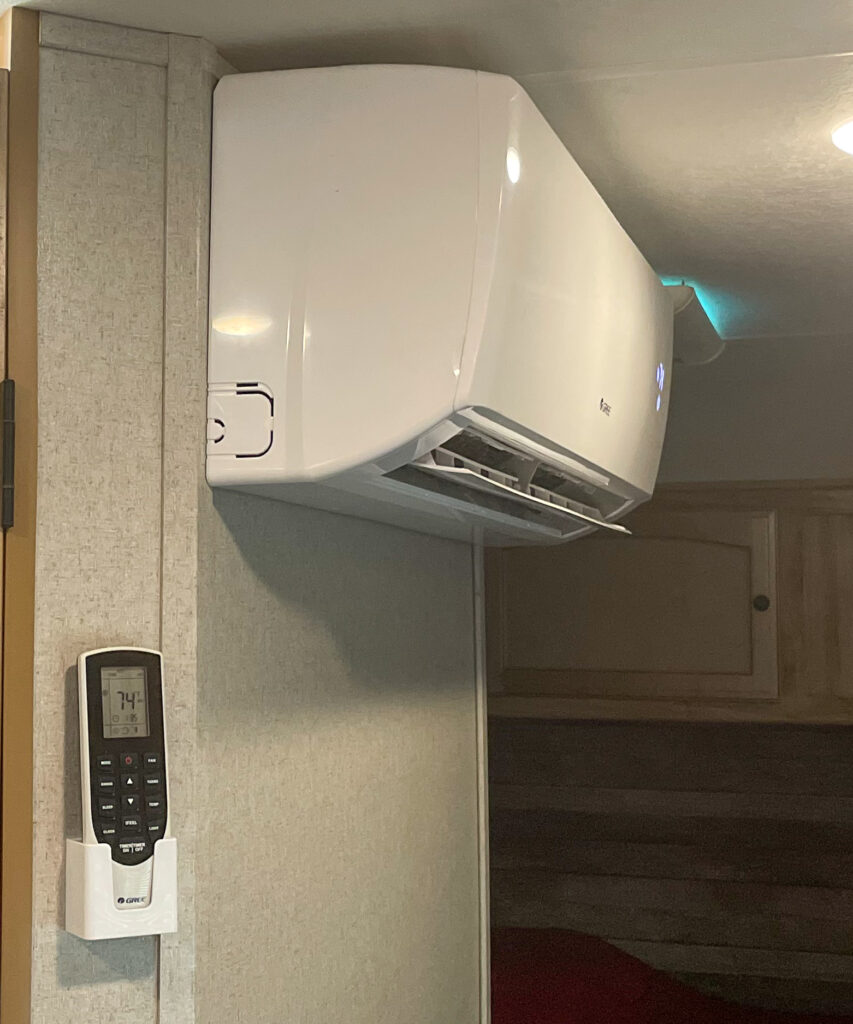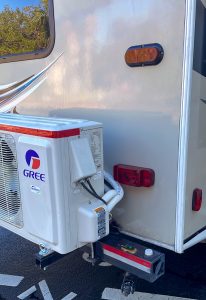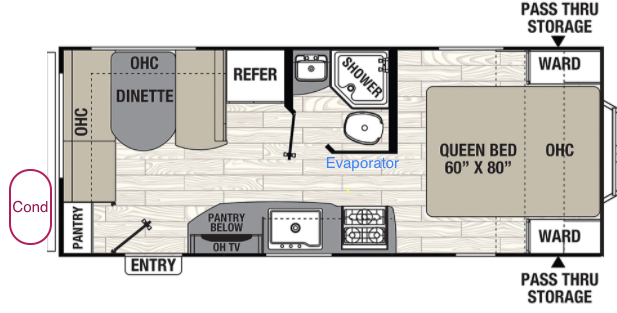Winnie, our 2019 Coachman Freedom Ultra-Lite travel trailer had a noise problem. Just as most travel trailers, motor homes, and other RVs, Winnie was delivered with a roof-top Dometic air conditioner that was made from salvaged rocket ship parts. At least it sounded like that when it is running.
Worse than just the noise that at least nearly prohibits conversation, the unit is located directly above our dining table, making pleasant dinner conversation impossible, especially if your hearing is slightly below perfect.
Several years ago, we had the same problem in our home. The original home unit was loud, drafty, and cycled from to warm to very cool about every 15 minutes.
We solved both problems by investing in new technology, variable speed inverter-driven air conditioners with fans that slow down to nearly inaudible at night when it is cooler outside. Even at full speed, we can not hear the unit (22 db) from either our bed or our dining table. The inverter is that piece of magic technology that makes noisy motors very quiet and raises the efficiency by eliminating all the noise. Remember Harry Potter explaining that science was for people who could not do magic? This new unit uses less than 1/2 the power of the Dometic it replaced (500 Watts compared to 1200 Watts) – truly magic in my limited understanding of how things work. There is no starting surge since the unit starts slowly and takes about 2 minutes to come up to full power.
Variable speed air conditioners such as the one we chose for Winnie are designed to automatically adjust their output of cold, or heated, air in response to the temperature of the space they are cooling or heating. In a RV running on generator power, this is especially important because the generator runs at a lower speed all the time, roughly 40% of the average speed of an older design unit. This means a lower, constant, noise level with less wear on the generator and your nerves. So, rather than listening to the generator struggle each time the unit begins the cool cycle, this unit is essentially always on, quiet, and sipping electrical power and generator fuel.
Winnie’s new unit is a Gree 9500 Btu/hour mini-split. The Gree unit draws about 45% of the power used by the Dometic and has no real detectable starting load since it is designed to start slowly and come up to speed over several minutes.  While our older Dometic strained and often failed to start with our 2 kW Honda generator, the Gree requires well under 50% of our Honda 2k rated power. The photo on the right shows the 422 Watt operating draw when the unit is maintaining 74° inside with the hot Florida sun outside. The photo is of a small $20 a/c electric meter we installed at the start of the project.
While our older Dometic strained and often failed to start with our 2 kW Honda generator, the Gree requires well under 50% of our Honda 2k rated power. The photo on the right shows the 422 Watt operating draw when the unit is maintaining 74° inside with the hot Florida sun outside. The photo is of a small $20 a/c electric meter we installed at the start of the project.
Put in perspective, several of these units will run on a single Honda 2k generator once the RV is cool. Two will run at full power when turned on during the mid-day sun just after you arrive at your campsite. In a larger RV, two inside evaporators, each with its own thermostat, can be operated with a single outside condenser. You can run a living room and bedroom cool air source on a single small generator and single outdoor condenser.
And, there is no draft – none. We tested the unit at 61 degrees (F) inside and went off for a few hours in the middle of a hot day with the unit in full Florida sun. When we returned to the trailer after the test, we actually shivered until the trailer warmed up to the cool, but comfortable, 68 degrees. Our normal set point is 75 degrees and the thermometer never varies.
The unit is designed to display either inside temperature or set point (thermostat setting), but we really can’t tell which is which since it is always capable of maintaining exactly the desired temperature. Even at the highest turbo setting designed for quick cooling when you have extra electrical power, it is nearly impossible to hear the inside component. On Turbo the compressor can be heard outside within a few feet of the back of the trailer and just barely heard inside.
Unlike our old roof unit, the mini-split is installed to route the water produced outside under the trailer rather than dripping off the roof with a slow drip-drip-drop from the lowest corner of the roof. The new unit draws just over a pint of water per hour out of the trailer air yielding a mold-free environment with none of the clammy feeling the Dometic roof unit used to produce. We run the unit 24/7 when at home for under $30 per month.
The travel trailer Air Conditioner performs exactly as we had hoped when be bought it.
The best part was the install. Dr. HVAC, Chris Ramnauth, quoted me a firm, fixed price for the entire install: the Gree air conditioning unit, building a custom bumper bracket for the condenser, hanging the wall evaporator in the center of the trailer and high enough to not bang my head, all the wiring, removing and replacing the bottom of the trailer to hide the refrigerant lines, and cleaning up the trailer better than he and his crew found it. Joan and I are really pleased with the price, the work, and the timing of the job. We dropped Winnie off at the Dr HVAC parking lot, Chris sent progress photos as the work progressed, and walked through the job showing us what was done – in a very cool, quiet trailer with the unit getting electricity from a an extension cord from his shop. No special plug, no heavy duty extension cord or wiring is required since the unit draws so little power. A 30 Amp plug in is required if you also plan to run the electric hot water or other heavy power appliance.
While you can’t see it in the photo, there is a 20 Amp inlet connecter behind the generator. The generator is plugged into the trailer with a 4′ 12 gauge extension cord. I installed a manual transfer switch ($25 from Home Depot) just under the distribution box to feed either the generator or shore power to the a/c distribution panel – there is no possibility of back feed.
We had planned to retain the original rooftop unit to quick cool when we arrived in camp. Turned out that was unnecessary. Even in the hottest day in Florida, we could drive into a rest area, start the Honda, visit the rest stop restroom, and return to a comfortable trailer on the way to being cool.
So, we gave the rooftop unit away to a Father/Son team who agreed to climb up on the roof, remove the unit and seal the hole. The removal took about 20 minutes. We were left with a not quite watertight hole that we screwed in from below and insulated with a 4″ block of foam and some reflecting foil. Then we installed a Winix 545 air cleaner that finally eliminated the lingering “new car” and “old mold” smell from Winnie. Finally we applied three tubes of waterproof caulk to eliminate the edge roughness where the plywood was screwed onto the roof. We sealed the wood and joints with Eternabond, hopefully with no leaks forever.
Dr. HVAC is located in Margate, Florida, near Ft. Lauderdale. You can find Chris at https://dr-hvac-inc.com/. I have no financial arrangement with Dr HVAC, just admiration of a good craftsman.
You can Click Here to read about our Axle repair during our Summer of 2021 trip.














